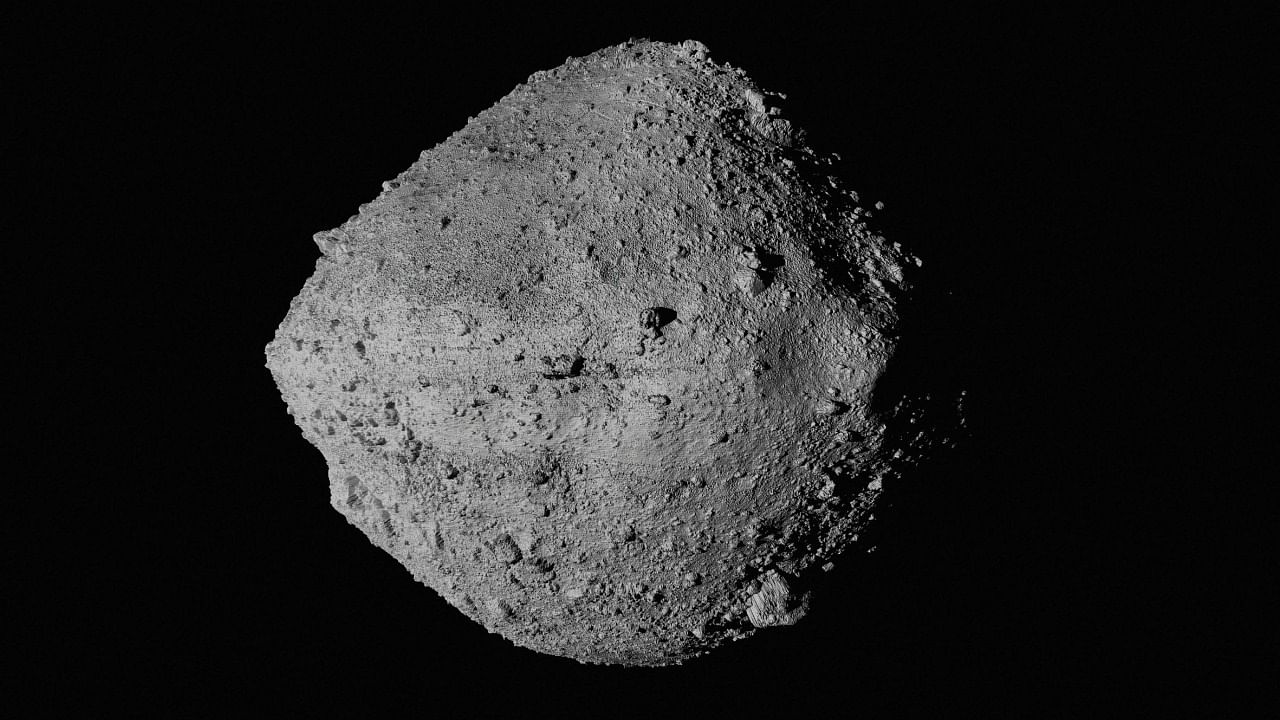
In 1999, astronomers discovered 101955 Bennu, a billion-year-old, half-a-kilometre wide asteroid, some 330 million kilometres from us. Asteroids are relics from the days when planets were forming. Bennu has intrigued scientists for many reasons: the oddball shape, spinning like a top, and the many craters that dot its surface. In addition, the asteroid has a carbon-rich composition resembling some earth meteorites. Scientists believe Bennu holds answers to our origins and may have brought the life-starting elements to Earth during a collision.
So in 2016, Nasa dispatched a mission to Bennu: a van-sized spacecraft, OSIRIS-REx, that would not only study Bennu but also scoop some soil from its surface and bring it back to Earth for analysis. OSIRIS-REx travelled for two years (2016-2018) to arrive at Bennu, only to be met with plenty of surprises that toppled our understanding of the asteroid. For the next two-and-a-half years, the spacecraft circled the tiny space object streaming millions of pictures and troves of data from its observations.
Earlier, ground- and space-based telescopes and spectral data showed that Bennu had a smooth, sandy beach-like surface with a few rocks and boulders. However, what OSIRIS-REx discovered is that Bennu is far from smooth. Instead, it is littered with rocks and boulders. “The rugged terrain went against all of our predictions,” reports Nasa, quoting Dante Lauretta, the lead investigator of the OSIRIS-REx mission. In early 2019, when the spacecraft was orbiting the asteroid at a distance of 1.6 km, the probe noticed Bennu was spitting out a plume of particles from its surface! “This is one of the biggest surprises of my scientific career,” remarks Lauretta.
Following this observation, the researchers escalated the probe’s orbits around Bennu. In the next few months, OSIRIS-REx observed more such particle plumes. Some of the many ejected particles orbited the asteroid, like satellites, and later returned to its surface. The team continues to study the data for plausible reasons for this. Thankfully, these particles did not pose a threat to the spacecraft. More tweaks had to be incorporated into OSIRIS-REx’s agenda. Earlier, the mission planned to land the spacecraft on a 25-foot hazard-free zone on the surface. However, the boulder-dense surface now posed hurdles for the probe to collect soil samples as it was no longer a feasible spot. In addition, the mission required high accuracy performance of the spacecraft, so the sample collection was deferred.
After zeroing on a safe spot called Nightingale, in late October 2020, OSIRIS-REx performed the magnificent feat. The space gymnastics, called Bullseye Touch-and-Go (TAG) sample collection event, lasted 5-6 seconds. First, the spacecraft hovered above the surface, then gently touched down within three meters of the target location. It then deployed a robotic arm with a foot-wide sampling head that scooped up some soil. Then, the container was immediately sealed, and the spacecraft lifted off.
The data analysis revealed that the lift-off occurred in the nick of time as Bennu’s surface particles were like a pit of plastic balls. They offered no resistance to the landing and could have sunk the probe. Quoting Rich Burns, the project manager of OSIRIS-REx at NASA’s Goddard Space Flight Center, Nasa says: “Throughout OSIRIS-REx’s operations near Bennu, our spacecraft and operations team have demonstrated that we can achieve system performance that beats design requirements.”
The analyses of the data from the probe show that Bennu’s spin rate is changing due to its uneven heating and cooling as it rotates in sunlight. As a result, the asteroid’s rotation period is decreasing by about one second per 100 years. In addition, data reveals that there are not many craters on its surface as envisaged earlier. The reason could be that Bennu is made up of a rubble pile of boulders and rocks with only a little gravity holding them together. Due to this, the rocks absorb impacts, preventing them from penetrating.
The scientists describe this as “the crumple zone in a car,” which absorbs the less energetic impacts without a trace. The probe is the first to orbit a small space body. OSIRIS-REx, short for Origins, Spectral Interpretation, Resource Identification, Security, Regolith-Explorer, is now on its return path to Earth. Time will reveal what other surprises these pristine sands hold.
(The writer is a science communicator)